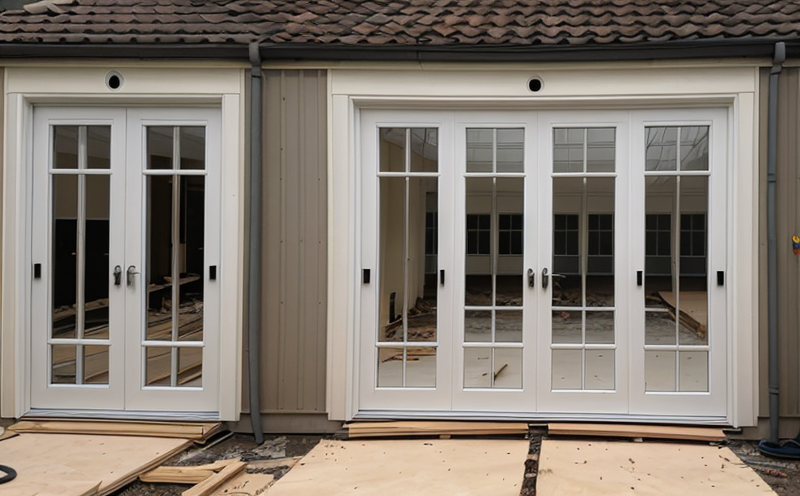Time-Temperature Curve Evaluation for Fire Doors
The time-temperature curve evaluation is a critical aspect of fire door testing that ensures doors meet stringent performance criteria under exposure to high temperatures. This assessment plays an essential role in validating the thermal insulation properties and structural integrity of fire doors, which are vital components in safeguarding buildings against fires.
During this test, fire doors are subjected to a controlled environment where they are exposed to increasing temperatures over time. The goal is to simulate real-world fire conditions that a door might encounter during an emergency. By measuring how well the door maintains its integrity and seals under these conditions, we can determine its effectiveness in containing smoke and heat.
The test follows specific protocols defined by international standards such as ISO 16733 and ASTM E1968. These guidelines provide a standardized approach to ensure consistency and reliability across different testing facilities. Compliance with these standards is crucial for manufacturers, installers, and end-users alike, as it guarantees that fire doors perform predictably in critical situations.
The evaluation involves several key steps: first, the door specimens are prepared according to the specified dimensions and materials required by the standard. Then, they undergo a rigorous testing process where they are exposed to increasing temperatures over time while being monitored for changes in structural integrity and sealing performance. Finally, detailed reports are generated based on the test results, providing comprehensive data on the fire door's performance.
Understanding the time-temperature curve is crucial because it helps us visualize how a fire door behaves under various thermal conditions. This information is vital not only for compliance with regulations but also for ensuring that buildings remain safe and secure during emergencies. By leveraging this test, we can identify potential weaknesses in design or materials early on, allowing manufacturers to make necessary adjustments before the product reaches the market.
The importance of time-temperature curve evaluation cannot be overstated, especially given the increasing frequency of fires worldwide. In recent years, there has been a growing emphasis on improving fire safety measures within buildings, and this test serves as one of many tools in achieving that goal. By investing in thorough evaluations like these, stakeholders can help protect lives and property against the devastating effects of fires.
| Parameter | Description |
|---|---|
| Temperature Range | The range of temperatures that the fire door is exposed to during testing. |
| Duration | The length of time each temperature level is maintained. |
Industry Applications
This evaluation method finds application across various sectors including commercial buildings, public infrastructure projects, residential complexes, and educational institutions. Compliance with fire door testing standards is mandatory in many regions around the world to ensure that structures adhere to local building codes.
| Sector | Application |
|---|---|
| Commercial Buildings | Ensuring fire doors meet the necessary standards for safety and compliance. |
| PUBLIC Infrastructure Projects | Incorporating fire door testing into construction projects to enhance overall safety. |
Quality and Reliability Assurance
The quality and reliability of fire doors are paramount, especially given the high stakes involved in their performance during emergencies. Our laboratory employs advanced equipment and methodologies to ensure accurate and consistent results. We use state-of-the-art furnaces capable of maintaining precise temperature controls throughout the test duration.
Our team of experts closely monitors each specimen’s behavior under varying thermal conditions, ensuring that no detail is overlooked. Rigorous quality checks are performed at every stage, from initial setup to final analysis. This commitment to excellence guarantees that only high-quality fire doors pass our evaluation process.
We adhere strictly to international standards such as ISO 16733 and ASTM E1968, which provide clear guidelines on how tests should be conducted. By following these protocols, we maintain consistency across all evaluations, allowing stakeholders to have confidence in the results obtained. Our rigorous quality assurance measures also help identify any deficiencies or areas for improvement early in the product lifecycle.
Our laboratory’s reputation for reliability and accuracy is built on years of experience and continuous improvement. We stay abreast of industry trends and advancements, ensuring that our methodologies remain cutting-edge. This dedication to excellence ensures that fire doors tested here are among the best available on the market today.
Competitive Advantage and Market Impact
- Educates stakeholders on the importance of thorough evaluation methods in maintaining high-quality standards.
- Highlights the role of fire door testing in enhancing overall building safety and compliance.
- Emphasizes the potential for early identification of design flaws through comprehensive evaluations.





